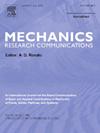Mesoscale damage analysis of UHTCC under seawater dry-wet cycles using particle flow theory
IF 2.3
4区 工程技术
Q3 MECHANICS
引用次数: 0
Abstract
This study investigates the effects of seawater dry-wet cycling on the dynamic compressive properties of Ultra-High Toughness Cementitious Composites (UHTCC) using a discrete element model developed with Particle Flow Code (PFC2D). Five sets of controlled laboratory dynamic compression tests with varying dry-wet cycles were conducted alongside numerical simulations to examine force chain evolution, crack propagation, and acoustic emission characteristics at the mesoscale level. Results demonstrate good agreement between numerical simulations and experimental data. The peak stress of UHTCC exhibited a non-monotonic response to increasing dry-wet cycles, initially rising before declining after reaching its maximum at 90 days. Acoustic emission events showed strong correlation with crack development, where increased crack density corresponded to higher signal intensity and event frequency. The developed discrete element model successfully captured the complete internal fracture process at microscopic scales, demonstrating its effectiveness for analyzing complex mechanical behaviors in cementitious composites.
基于颗粒流理论的海水干湿循环下UHTCC中尺度损伤分析
采用颗粒流程序(PFC2D)建立离散元模型,研究海水干湿循环对超高韧性胶凝复合材料(UHTCC)动态压缩性能的影响。在不同干湿循环下进行了五组受控实验室动态压缩试验,并进行了数值模拟,以研究中尺度水平上的力链演化、裂纹扩展和声发射特征。结果表明,数值模拟与实验数据吻合较好。UHTCC的峰值应力对干湿循环的增加表现出非单调响应,在90 d达到最大值后先上升后下降。声发射事件与裂纹发展有很强的相关性,裂纹密度越大,信号强度和事件频率越高。所建立的离散元模型成功地在微观尺度上捕获了完整的内部断裂过程,证明了其在分析胶凝复合材料复杂力学行为方面的有效性。
本文章由计算机程序翻译,如有差异,请以英文原文为准。
求助全文
约1分钟内获得全文
求助全文
来源期刊
CiteScore
4.10
自引率
4.20%
发文量
114
审稿时长
9 months
期刊介绍:
Mechanics Research Communications publishes, as rapidly as possible, peer-reviewed manuscripts of high standards but restricted length. It aims to provide:
• a fast means of communication
• an exchange of ideas among workers in mechanics
• an effective method of bringing new results quickly to the public
• an informal vehicle for the discussion
• of ideas that may still be in the formative stages
The field of Mechanics will be understood to encompass the behavior of continua, fluids, solids, particles and their mixtures. Submissions must contain a strong, novel contribution to the field of mechanics, and ideally should be focused on current issues in the field involving theoretical, experimental and/or applied research, preferably within the broad expertise encompassed by the Board of Associate Editors. Deviations from these areas should be discussed in advance with the Editor-in-Chief.

 求助内容:
求助内容: 应助结果提醒方式:
应助结果提醒方式:


